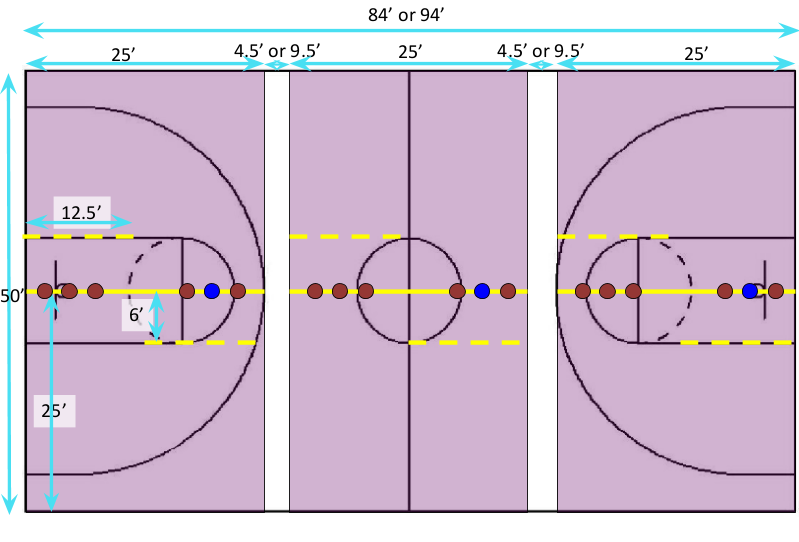Season 2017 Events:
2016-10-22: UWP / Blue & Orange Ball Chucking Bonanza
2017-05-06: WDS Open Rubber at FitExpo Chicago
This outline serves to inform the very basic rules, and also specifically noting the differences when comparing the NCDA’s 12 on 12 Rulebook or Elite Dodgeball’s Ruleset.
Updated 2016-10-21
Equipment & the Court
- Dodgeballs – Six 8.5” rubber balls will be used in this style of play.
- Burden Ball – One dodgeball will be of a different color than the other five, or a significant pattern to the other five solid colored balls. This is the Burden Ball.
- Pinching, gripping, and/or crushing the ball is allowed.
- Court – The Court will be 50’x25’ (15.25m x 7.625m).
- Soft Boundaries – The Sidelines and Baselines have soft boundaries. One point of bodily contact inside the boundary lines must be maintained; if all points of bodily contact are outside the boundary lines, the player is ruled out by boundary violation.
- Catching – A Catcher must maintain one point of bodily contact in bounds in order for a Catch to count.
- Halfcourt / Attack Line – A line marked from sideline to sideline splitting the court into equal halves. Halfcourt will act as the Attack Line; there is no Neutral Zone. This is a hard boundary line. Any player that makes contact upon the marking of the Attack Line or beyond the Attack Line, with any part of their body, is ruled out by boundary violation. Attack Lines extended indefinitely beyond the Sidelines.
- Activation Line – A parallel line six feet from the halfcourt line. Balls are activated by being brought behind this line during the Opening Rush.
- Ball Placement – Six dodgeballs are split into two ball placement sections and placed on Halfcourt. Each section is defined by a mark made six feet from the Sideline. Teams may order and place their three balls to their liking within the six foot section of Halfcourt.
- Initial Burden Placement –
- Round Robin – Agreement between the captains (ie: coin flip, rock/paper/scissors, etc)
- Playoffs – The higher seeded team chooses the burden regardless of position in the bracket.
- The Burden Umpire will stand on the sideline closest to the initial placement of the burden ball.
- Soft Boundaries – The Sidelines and Baselines have soft boundaries. One point of bodily contact inside the boundary lines must be maintained; if all points of bodily contact are outside the boundary lines, the player is ruled out by boundary violation.

Teams
- Rosters – Each team may consist of a roster of 5-8 players. All members of the roster must meet the NCDA eligibility requirements outlined in the NCDA Rulebook [2.3.1.1 and subpoints].
- Teams – This version of Dodgeball is played with a maximum of six and a minimum of five players on the court, at the start of a point.
- Multiple Competitors – Each institution of higher education may send two participating teams to compete.
- Nomenclature – If more than one team, the teams must be labeled “[School Acronym] Team A” and “[School Acronym] Team B”.
- Uniforms – All members of a team should have tops of the same color and style. Teams should make an effort to meet requirements outlined in the NCDA Rulebook [2.3.2 Team Uniform and Equipment]
- Matching Jerseys – Both teams may wear similar jerseys. If two teams are wearing similar jerseys and must play each other, Team B will be asked to place a single strand of visible tape across the chest of their jersey to distinguish the two teams during the game.
- Permission to Compete – If the team is competing in the NCDA for the first time, it is not required that they become a student-recognized organization on campus prior to competing. They will, however, need the expressed written consent of their Student Organization or Club Sport department to compete in this style of tournament. The NCDA will also require all members to sign a liability waiver per point 7.9 of the NCDA Bylaws.
Game Format
- Scoring – Each match will be comprised of three Points; all three Points will be played for ranking purposes. The team who wins two Points will win the match.
- A point is scored when one team completely eliminates the opposing team from the field of play.
- After each Point, teams will switch sides and officials will replace the balls at Halfcourt.
- Opening Rush – The Referee will signal each team for readiness, then whistle to begin play. Teams may only rush for the three balls on their right.
- Activation of Balls – After the Opening Rush, dodgeballs must activated by a player with two feet behind the Attack Line. Balls can be brought back, passed, or relayed. All dodgeballs are considered active ten (10) seconds after the Opening Rush.
- Burden Ball – The team possessing the majority of dodgeballs will have the burden and will have ten seconds to relieve themselves of the burden. If the burden is not relieved, the violating team must forfeit all of their balls to the other team.
- A team in possession of 6 balls must relieve 3 balls, including the burden ball. Throwing only the off-color ball will not relieve the Burden.
- A team in possession of 5 balls must relieve 2 balls, including the burden ball if it is in their possession. Throwing only the off-color ball will not relieve the Burden.
- A team in possession of 4 balls must relieve 1 ball, including the burden ball if it is in their possession. In this case, throwing the burden ball will relieve the Burden.
- If both teams have three balls, then the team with the Burden Ball (the ball of a different color) will have the burden to throw.
- The burden count may not begin unless all dodgeballs are in bounds. A slightly out of bound ball that are reachable by a player is counted, at the Burden Umpire’s discretion..
- In order to relieve the burden, balls do not have to enter any Legitimate Attempt Zone (see NCDA Rulebook).
- Timeouts – There are no timeouts.
- Substitutions – There are no in-game substitutions except in the case of injury. Only members of the roster who were not active at any point during the game, can be substituted in for an injured player.
Gameplay
- Please review the NCDA Rulebook for full detail.
- Basics – Each team tries to hit players on the opposing team by throwing balls at them. Any ball thrown by a live player is considered a directly thrown ball by a “Thrower”. A “Target” may make a play on a direct throw.
- Dodging – If a direct throw does not hit the Target’s body or clothing, the Target dodged the ball. The Target is safe.
- Blocking – A Target can use a dodgeball to block any direct throw. However, the blocking dodgeball(s) must remain secure after being hit, and the deflection must not hit the blocking Target’s body. In a successful clean block, the Thrower and the Target are safe.
- Knockout – If a blocking ball becomes dislodged, the Target must regain possession before the dislodged ball becomes dead. Failure will result in the Target being ruled out by Loss of Possession.
- Dirty Block – If the ricochet hits the blocking Target, a catch must be made on the ricochet before the ricochet becomes dead. Failure will result in the Target being ruled out by failing to catch.
- Block Assisted Personal Catch – If the blocking Target catches the ricochet, it counts as a Personal Catch. A player from the Target’s jail comes back into play. The Thrower is out by throwing a catch.
- Block Assisted Team Catch – If a teammate of the Target catches the ricocheted ball before it becomes dead, it is deemed a Block Assisted Team Catch. A player from the Target’s jail comes back into play. Neither the Target nor the Thrower are out.
- Direct Hit – If a Target is struck on any part of their body or clothing with a directly thrown ball, and fails to catch the ricochet, the Target is out by failing to catch.
- Personal Catch – If a Target catches a direct throw, a player from the start of the Target’s jail comes back into play. The Thrower is out by throwing a catch.
- Team Catch – If a directly thrown ball hits a Target and a teammate of the Target catches the ricocheted ball before it becomes dead, it is deemed a Team Catch. A player from the start of the Target’s jail comes back into play. Neither the Target nor the Thrower are out.
- Suicides – If a player jumps from their Team Zone, over the Attack Line, and throws their ball before landing out of bounds, the Thrower’s ball is acts as a directly thrown ball and may cause a direct hit. The Thrower is ruled out once they contact the ground; any dodgeballs secured in their possession are ruled dead when they land out of bounds.
Injuries, Conduct, and Penalties
- Please review the NCDA Rulebook for full detail.
Officiating
- There will be two officials per match:
- Referee – This head official will actively make calls, maintain the integrity of the game, and time the duration of each point. The Head Referee will whistle to begin each Point.
- Umpire – This assisting official will keep track and signal the Burden and assist the head official on calls when asked.
- Crew will maintain statistics
- Duration of each Point, from whistle to last out.
- Duration of each Match, from beginning whistle on the first Point to the last out on the third Point.
- Any injuries, penalties, or other timeouts, and when they occurred in the match.
- Box score of the Match [UCONN def UCLA 2-1]

























